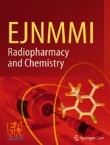Topical Collections about latest and interesting topics in EJNMMI Radiopharmacy and Chemistry are available at: https://link.springer.com/journal/41824/collections
Improved non-invasive positron emission tomographic imaging of chemotherapy-induced tumor cell death using Zirconium-89-labeled APOMAB®
The chimeric monoclonal antibody (mAb) chDAB4 (APOMAB®) targets the Lupus associated (La)/Sjögren Syndrome-B (SSB) antigen, which is over-expressed in tumors but only becomes available for antibody binding in ...

